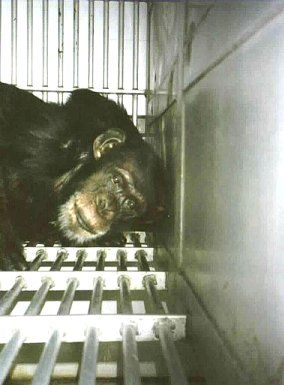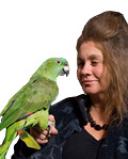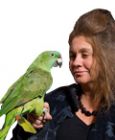
According to a report in today's New York Times, "Chimps' days in labs may be dwindling." [2] Should Congress pass the Great Ape Protection and Cost Savings Act of 2011 [3], this may indeed be true. The legislation bans invasive research on all great apes, chimpanzees, bonobos, gorillas, gibbons, and orangutans.
Imagine there's no heaven
For those currently incarcerated and subjected to invasive research, it is easy to imagine that there is no heaven. The Act defines ‘invasive research' as "any research that may cause death, injury, pain, distress, fear, or trauma to a great ape, including [3]:
1. The testing of any drug or intentional exposure to a substance that may be detrimental to the health or psychological well-being of a great ape. Jeannie was a chimpanzee who spent nine years at Laboratory for Experimental Medicine and Surgery in Primates (LEMSIP). She was infected with HIV, hepatitis NANB, and C virus, and used in rhinovirus vaccine studies. [4,5,6,7]
2. Research that involves penetrating or cutting the body or removing body parts, restraining, tranquilizing, or anesthetizing a great ape. Jeannie experienced over 200 "knockdowns" (anesthetization by dart gun) and underwent repeated vaginal washes, multiple cervical procedures, liver punch, wedge, and lymph node biopsies.
3. Isolation, social deprivation, or other experimental manipulations that may be detrimental to the health or psychological well-being of a great ape. Jeannie lived in 5x5x7 cage suspended along a fixed ceiling track alongside cages in which other chimpanzees were also individually housed. Gloria Grow, director of the Fauna Foundation where Jeannie would one day be able to find refuge and care, visited the facility and observed Jeannie in her cage. She began screaming and spinning. The other chimpanzees began to scream and display fear-grimacing. Jeannie continued to scream, frothed and salivated, rolled her eyes back, urinated and defecated, and forcefully hit her body against the four sides of her steel cage.
No people below us, above it's only sky
At the lab, Jeannie had a history of severe weight loss from recurring anorexia. She would often take her food and arrange each piece ritualistically in a circle around her, an effort, perhaps, to create her own inner sanctuary. At Fauna, she was able to regain weight and some semblance of health. However, she was plagued by the legacy of her torture. She vacillated between complete calm and sudden, unpredictable aggression, at times engaging in self-mutilation and agitated behavior.
Jeannie had many medical issues including asthma, skin problems, autoimmune disorders, upper respiratory distress, and seizure-like episodes. Her motor coordination was poor, and when walking had to hold onto the enclosure bars.

Photo credit: Fauna Foundation
She died at 31.
Imagine there's no countries
Rachel is another survivor now living at Fauna. [6,8] She lives in almost constant distress, rocking her head continuously and whimpering. She will suddenly focus on her hand or foot and then start screaming in terror as if the body part has transformed into something foreign or threatening. She will hold it away from her, distance it as if the hand or foot is not her own and then begin to attack it so violently that it bleeds profusely. At other times Rachel strikes her own head forcefully, ceasing only when she sees blood or becomes exhausted.
Nothing to kill or die for
These captive individuals are tortured. Tortured is an apt and accurate descriptor by the standards of science, given what we know about other animal brains and minds, and the Geneva Convention. Animals are tortured just so humanity can live longer and better. Perhaps the banning of great ape torture heralds the beginning of a new humanity that care more for the ethical quality of life than it does for quantity.

Photo credit: Lorin Lindner
Imagine all the people, living life in peace
Over 1000 great apes and thousands more of other nonhuman primates and millions of rats, birds, and other animals are held captive for experiments, schools, testing, entertainment, and as "pets." Jeannie's and Rachel's symptoms are common among all such individuals. Birds may not look like us, but they are "feathered apes," who suffer the institutionalized trauma of captivity as we and other apes do. [9,10]
It's easy if you try
It is well time that we utilize our self-acclaimed powers of empathy, intelligence, and mirror neurons to cease the practice of animal torture and forced confinement. Let's pass a bill that bans all use of animals for research, testing, and experimentation-not to save money, but because it is right.
Imagine all the people, sharing all the world
Imagine a world where animals do not have to fear humans. Imagine a world where humanity does not feel compelled to subject animals to suffering. Imagine.
You may say I'm a dreamer
But I'm not the only one
I hope someday you'll join us
And the world will live as one
Literature Cited
[1] Lennon. J. Imagine.
[2] Gorman, J. 2011. Chimps' days in labs may be dwindling.
[3] Great Ape Protection and Cost Savings Act of 2011
[4] Fauna Foundation. 2011.
[5] Fauna Foundation. 2011. Jean.
[6] Bradshaw, G.A., Capaldo, T, Lindner, L & G. Grow. 2008. Building an inner sanctuary: trauma-induced symptoms in non-human great apes. Journal of Trauma and Dissociation, 9(1), pp. 9-34.
[7] Bradshaw, G.A., Capaldo, T, Lindner, L & G. Grow. 2009. Developmental context effects on bicultural post-trauma self repair in Chimpanzees. Developmental Psychology, 45, 1376-1388.
[8] Fauna Foundation. 2011b. Rachel.
[9] Emery NJ. 2004. Are corvids feathered apes? Cognitive evolution in crows, jays, rooks, and jackdaws. In: Watanabe S, editor. Comparative analysis of minds. Tokyo: Keio University Press, pp. 181-213.
[10] Orosz, S. & G.A. Bradshaw. 2007. Avian neuroanatomy revisited: From clinical principles to avian cognition, In: The veterinary clinics of North America: Exotic animal practice. Neuroanatomy and neurodiagnostics. (eds. L. Tell and M. Knipe), 10(3), 775-802.




